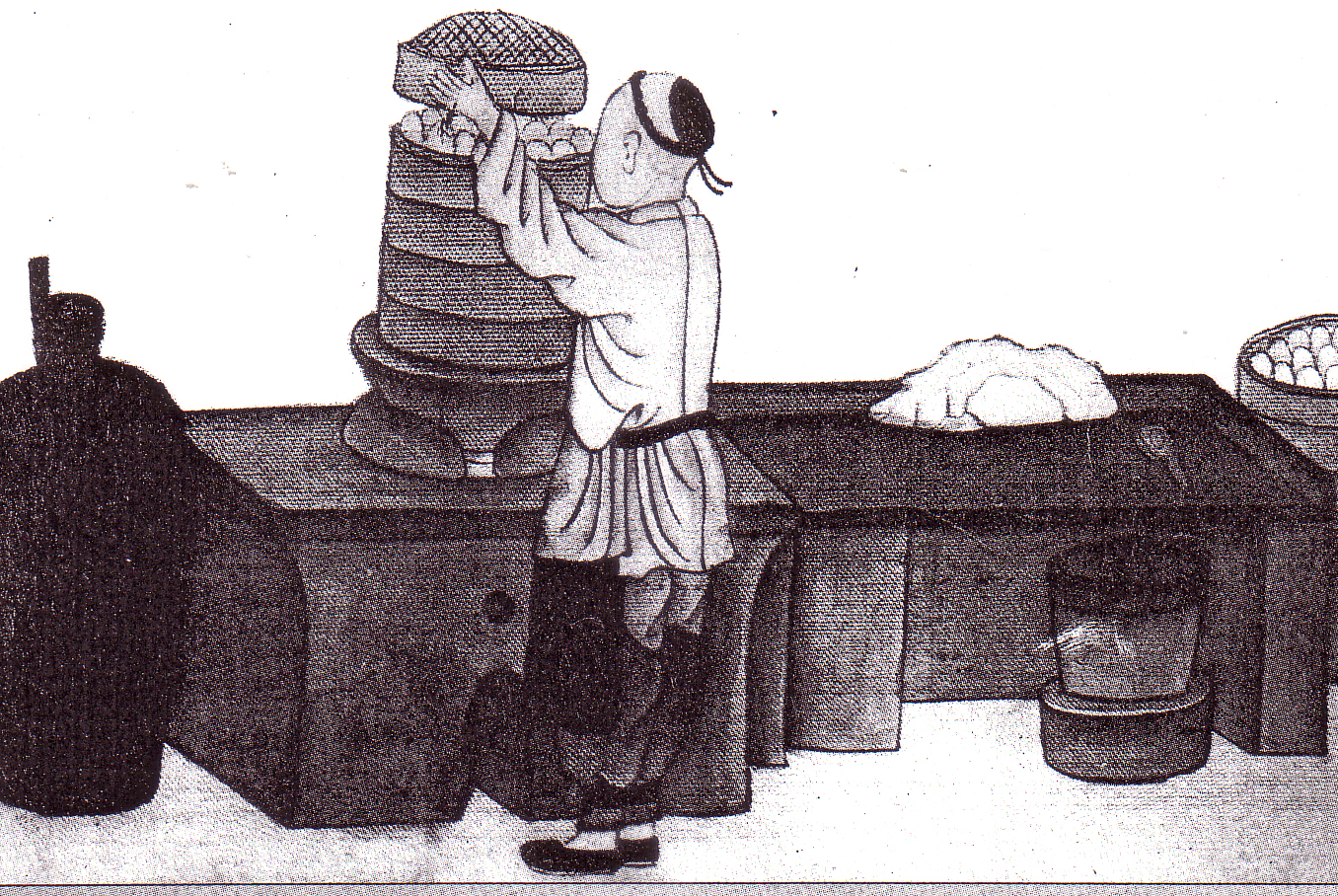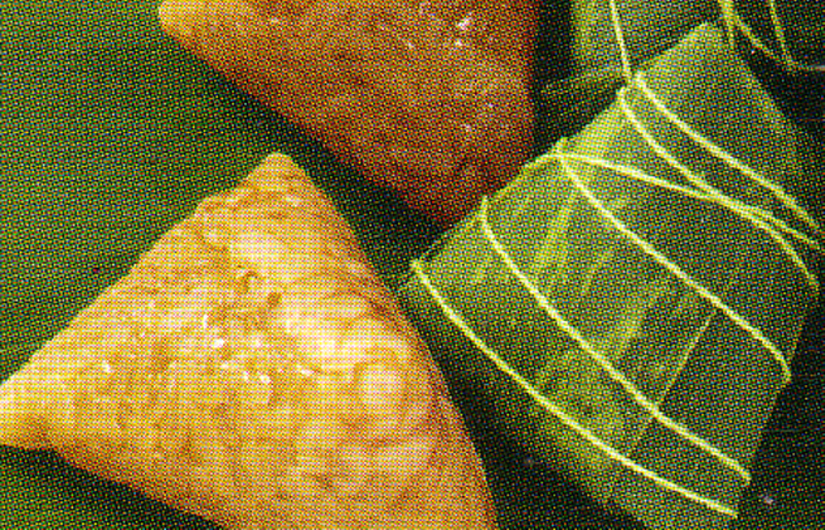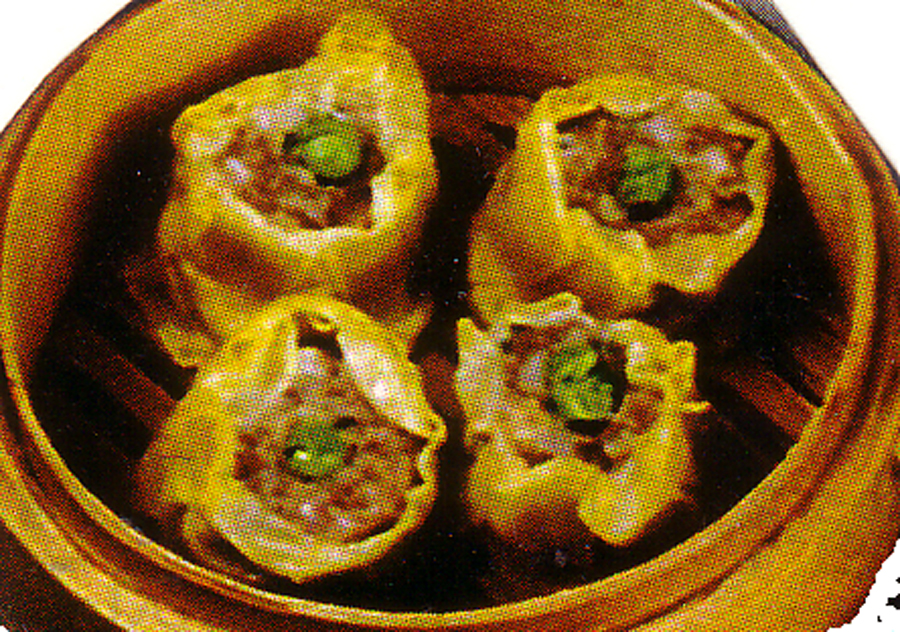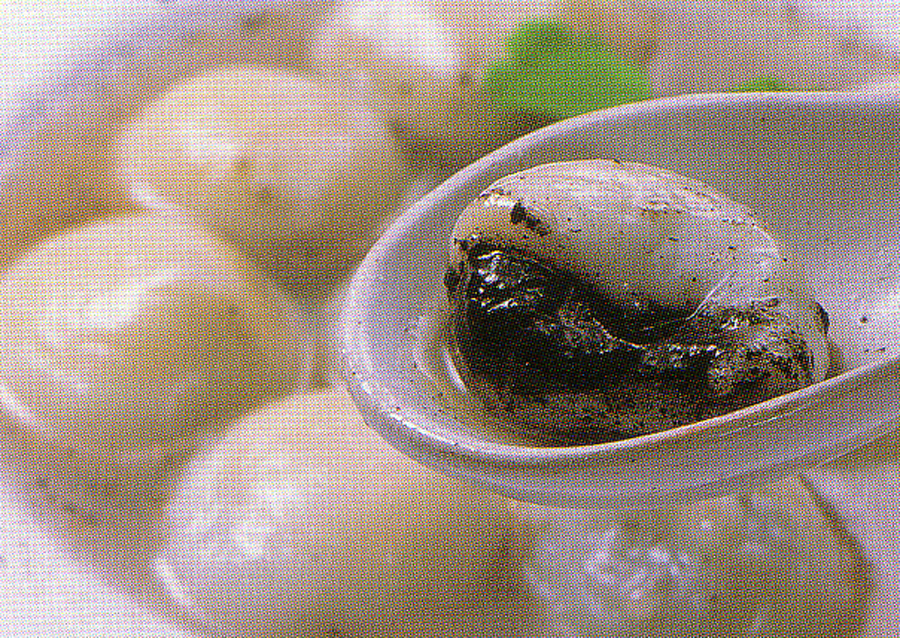
| What is Flavor and Fortune? |
| How do I subscribe? |
| How do I get past issues? |
| How do I advertise? |
| How do I contact the editor? |
Read 12687105 times
Connect me to:
| Home |
| Articles |
| Book reviews |
| Letters to the Editor |
| Newmans News and Notes |
| Recipes |
| Restaurant reviews |
| Article Index (all years, slow) |
| List of Article Years |
| Article Index (2025) |
| Article Index (last 2 years) |
| Things others say |
| Related Links |
| Log In... |
| Authors |
| Categories & Topics |
Dumplings: Holiday, History, and Happiness--Part I
| by Jacqueline M. Newman |
Dim Sum and Other Snack Foods
Summer Volume: 2008 Issue: 15(2) page(s): 11, 12, and 13
Baked, boiled, steamed, pan-fried, or prepared in any other way, dumplings by any name, are ancient and modern and everything in-between. Most often, they are wrapped in dough. However, their exteriors can be made using lots of different food items. They come in every size from tiny to larger than most people think, and in every shape one can imagine. Morning, noon, and night, looking lovely or less so, dumplings can be sweet or savory, an art form or hardly artful, and eaten to accompany tea, please the palate, dot the heart, and satiate mind and body.
 Dumplings have a long history. It is said that Zhang Zhongjing invented these diverse delights during the Han Dynasty (206 BCE - 220 CE). He did so while investigating medicines. He thought some might cure thyroid conditions, others prevent frostbitten ears, and still others improve a host of other conditions. His ideas about these delicious bites, wrapped or not might be over-stretched notions. There are no pictures of them in his time, but the 18th century item on this page and on the magazine’s cover does tell us they are not new.
Dumplings have a long history. It is said that Zhang Zhongjing invented these diverse delights during the Han Dynasty (206 BCE - 220 CE). He did so while investigating medicines. He thought some might cure thyroid conditions, others prevent frostbitten ears, and still others improve a host of other conditions. His ideas about these delicious bites, wrapped or not might be over-stretched notions. There are no pictures of them in his time, but the 18th century item on this page and on the magazine’s cover does tell us they are not new.
There are dumpling variations made in many different regions. The information above does indicate they were recorded in a Han Dynasty volume; it was called Notebook of Local Customs. This information is not reported in many places, and we are grateful to share it with you.
 Very old dumplings were said to be triangular in shape, as are dragon boat dumplings these days, were made with cooked millet and wrapped in bamboo leaves. They were eaten on the fifth day of the fifth month, also on the Summer Solstice holiday. They are probably the origin of the shape now prepared for the Dragon Boat Festival illustrated on this page. The recipe for them at the end of this article is a recent one that lots of people prefer.
Very old dumplings were said to be triangular in shape, as are dragon boat dumplings these days, were made with cooked millet and wrapped in bamboo leaves. They were eaten on the fifth day of the fifth month, also on the Summer Solstice holiday. They are probably the origin of the shape now prepared for the Dragon Boat Festival illustrated on this page. The recipe for them at the end of this article is a recent one that lots of people prefer.
Triangular Millet Dumplings were an early type of dumpling. They had another name, glutinous millet dumplings. The millet in them was boiled with ‘concentrated vegetable lye’ and they were mushy. The rice in them was soaked in water until soft, and it was two parts rice to one part millet. Instructions we read said to put one layer of rice and one layer of millet inside a wide bamboo leaf, wrap and tie this with string, and boil for ‘the amount of time it takes to steam 10 shih of rice.’ No other place have we seen this recipe, so perhaps readers can expand our knowledge on this issue. The recipe below is also a layered one, but it does not use millet.
The use of dumplings at tea houses became fashionable in Southern China some time before the Song Dynasty (960 - 1279 CE). Siu mai, also written as shu mai, were the most popular kind then. They were and still are filled with finely minced pork and shrimp or crab meat. Some include dried then soaked chopped Chinese mushrooms, fresh water chestnuts, and more. Today we see them adorned with crab roe in fancy places, a green pea in middle of the road eateries as are the ones shown on this page, and with no decor in everyday spots.
 Siu mai are still popular appetizer/snack/dim sum foods in the south of China. They are meant to be consumed with tea. Lots of places serve them with chrysanthemum tea. Large places serve them on wagons or trays stacked high, usually four dumplings to one small steamer basket. They used to be available from early morning to long after midnight. Nowadays, they are served from late morning to before three in the afternoon; and rarely found around the clock.
Siu mai are still popular appetizer/snack/dim sum foods in the south of China. They are meant to be consumed with tea. Lots of places serve them with chrysanthemum tea. Large places serve them on wagons or trays stacked high, usually four dumplings to one small steamer basket. They used to be available from early morning to long after midnight. Nowadays, they are served from late morning to before three in the afternoon; and rarely found around the clock.
The words 'dim sum' are often translated as 'dot the heart.' The first part of their name, 'dim' can mean 'point' and the second part or 'sum' means 'heart.' Less literally, they point to the heart of many of their consumers. In Hong Kong these snack foods are called yum cha or 'tea-drinking foods.' They play an important social role as families and friends gather on week-ends or holidays to enjoy them together.
Dumplings in China are remembered in Hong Kong. They were super Shanghainese ones at Xiao Nan Guo, upstairs at 68 Des Voeux Roar, Central District; phone 2259-9393. We did set foot in that dim sum eatery quite a few times on our visits there. On a week-end, almost everyone is eating soup dumplings and lots of other snack foods. Any large Chinatown restaurant, and we mean one with three hundred to three thousand seats, has multi-generational families packing their places. Some are reading the paper or a book brought along. Some are chatting amongst themselves and greeting others nearby. Almost everyone is eating and eating many small wonderful plates of the dim sum/yum cha dishes being offered.
Dumplings in the USA are in many citues. One does not need to cross an ocean to enjoy fine dim sum, nor does one need to go back in time. Green Village, 140 W. Valley Boulevard, San Gabriel CA; phone 626/288-5918 is on the west coast. East Manor, in many locations on the East Coast, and places in between satiate and satisfy many Chinese and non-Chinese who appreciate these snack foods served daily, on week-ends, and especially at festival times. During the week there are fewer selections, on week-ends and holidays, it is not uncommon to be offered a hundred or more different ones. Choosing among them is no easy task.
Holidays often feature special dumplings. For example, before and during the Ming and Qing Dynasties (1368 - 1644 and 1644 - 1911 CE, respectively), folk customs about making and eating dumplings on Chinese New Year became somewhat formalized. Families reunited for New Year and other holidays and making them at home was an important part of their getting together. They caught up on what transpired during the year, especially from those who returned home for this holiday. Fewer make these feasting foods now. 'Spring Festival' was and still is a time to catch up but only those thought to be old-fashioned still prepare lots of these New Year ones at home. As a family, they now go out to the big dim sum emporia and enjoy them there.
In days past, families sat on their haunches, stools, or chairs and chatted, kneaded and/or rolled dough for wrappings, and chopped and mixed fillings to make hundreds upon hundreds of dumplings. They filled the circles or squares of dough, pinched them closed, set some aside for later, and boiled lots of them after they were filled. Lots were left to eat the next day and throughout the fifteen-day New Year/Spring Festival holiday. Once, we visited a friend during this time of year, and noticed three beds full of uncooked dumplings awaiting folks like us to come and share. What a treat!
Some families made theirs on New Year’s Eve but only after the clock struck midnight did they cook and eat them. Jiaozi and other stuffed items were wanted, kneaded, and needed by all. These dumplings were a way to say goodbye to the old year and welcome in the new. In the south and north of China, many families made them and glutinous rice balls, glutinous rice cakes, and/or noodles. They made and ate these dumplings and other foods as a Spring Festival meal and throughout this fifteen day holiday.
Minority populations in China had their own set of New Year rituals and foods. At least one among them was dumpling related. Mongolians enjoyed hundreds of boiled beef-filled dumplings with their New Year meal. For them, they also made hundreds of them, but they ate all of them that very night along with the rest of their dinner. Leftovers from the meal were a must, and the must was meat and wine, both items to welcome in their New Year and wish for prosperity. During the rest of the New Year and the rest of the year, they made flattened dumplings called bing. These were eaten often as snacks.
Some minorities make New Year dumplings rolled in minced dried shrimp, others rolled theirs in black and white rice. Some fill them with fish and wrap them in sheets of tofu. There is no limit to the variety of exterior and interiors that dumplings can have, be they made by Han populations or any of the Chinese ethnic minority groups.
 At the end of New Year festivities for the Han, a special dumpling, yuan ziao are the dumplings of choice. These are made of glutinous rice stuffed and shaped like balls. They are put into a sweet soup, and the most popular among them are stuffed with ground black sesame seeds as are those pictured on this page. Stuffings for these balls vary and might be osmanthus or rose flower paste, mashed and sweetened beans, white sesame seeds, or any food such as meats and vegetables. The fillings can be sweet or savory, are always made in large quantities, and large the numbers of them made each year to end the holiday are often in the hundreds.
At the end of New Year festivities for the Han, a special dumpling, yuan ziao are the dumplings of choice. These are made of glutinous rice stuffed and shaped like balls. They are put into a sweet soup, and the most popular among them are stuffed with ground black sesame seeds as are those pictured on this page. Stuffings for these balls vary and might be osmanthus or rose flower paste, mashed and sweetened beans, white sesame seeds, or any food such as meats and vegetables. The fillings can be sweet or savory, are always made in large quantities, and large the numbers of them made each year to end the holiday are often in the hundreds.
There is lots more to tell about dumplings. Part Two of this Dumplings are Holidays, History, and Happiness article will be continued in the next issue. It will also include more about where to eat them. In addition, there will be many more recipes.
| Siu Mai |
|---|
2 shrimp, minced 1 sprig cilantro, minced 6 Tablespoons minced or ground pork 2 Chinese black mushrooms, soaked, stems discarded, and minced 1 Tablespoon rendered chicken fat 1/4 teaspoon coarse salt 2 Tablespoons cornstarch 1 teaspoon sugar 1/2 teaspoon sesame oil 1/2 teaspoon chicken bouillon granules 12 round wheat flour dough with egg wrappers 1 teaspoon shrimp or crab meat roe Preparation: 1. Mix all ingredients and three tablespoons cold water, except the wrappers and crab roes, stirring for two minutes until sticky. 2. Take one tablespoon of the filling and put it n the center of the dough, and bring wrapper up making a round dumpling, no dough on its top side. Put a quarter teaspoon roe on the center of the top. Place of a leaf or a piece of parchment paper on a steamer basket, and put the siu mai on it. Repeat until all wrappers are filled and topped with a small amount of roe. 3. Steam over rapidly boiling water for ten minutes, remove, and serve.
|
| New Year Sesame Dumplings |
|---|
1/2 cup black sesame seeds 2 Tablespoons vegetable oil 1 Tablespoon shelled raw peanuts, skins removed 2 Tablespoons walnut pieces, soaked in boiling water for ten minutes, skins rubbed off 3 Tablespoons granulated sugar 1/4 cup lard 2/3 cup glutinous rice flour 1 Tablespoon all purpose flour 3 ounces pearl sago. Soaked in warm water for ten minutes, then drained, reserving the water Preparation: 1. Grind sesame seeds, and set aside. 2. Heat oil and fry peanuts, drain them then fry the walnut pieces in same oil, and drain them. 3. Grind peanuts and walnuts, mix with sesame seeds, and mix in the sugar and the lard; then make ten balls of the nut mixture and set them aside on a flat plate. 4. Mix rice and wheat flours,, add one-quarter cup of water and make into a ball of dough. Divide into ten pieces, and roll each one into a two-inch circle. 5. Put one batch of nut mixture on one dough circle, and wrap pinching the dough around the nut mixture; roll into a nicely-shaped ball; and repeat until all ten balls are made. Roll each of them into the sago and using a little of the remaining oil, put them on an oiled plate, about one inch apart from each other. 6. Steam over boiling water for six minutes, and remove from the steamer into a bowl of boiling reserved water with added sugar, if desired. Then serve.
|
| Dragon Boat Festival Zong zi |
|---|
2 pounds glutinous rice 1 teaspoon vegetable oil 2 pounds dry mung beans 1 Tablespoon sugar 2 teaspoons salt 24 dried bamboo leaves 8 dried lotus leaves 4 ounces dried Chinese black mushrooms, soaked for one hour, then discard the stems 8 salted egg-yolks 8 fresh chestnuts, exterior skin removed and discarded, cooked for half an hour 2 teaspoons five-spice powder 4 0unces canned lotus seeds 2 teaspoons thin soy sauce 1 pound roast pork, coarsely chopped Butcher’s twine to wrap the leaf packages Preparation: 1.Wash and soak separately, rice and mung beans in water overnight. Drain each and set them aside separately. 2. Add oil, sugar, and salt to the soaked rice, mix well, and divide into sixteen parts. Divide the mung beans into sixteen parts. Set both aside for later use. 3.Rinse then soak the bamboo and the lotus leaves for three hours or overnight. Fold in each lotus leaf making it into a large square. Cut away the pointed end of each bamboo leaf. 4. Put three bamboo leaves on top of the square lotus leaf. 5. Put pork, chestnuts, lotus seeds, and mushrooms in a bowl and add five spice powder and soy sauce and mix them well. Divide this mixture into eight equal parts. 6. On the stack of lotus and bamboo leaves, put one part of rice mixture, one part of mung beans. On this put one part of pork mixture and one salted egg-yolk. Cover this with one part of mung bean mixture and one part of the rice mixture. 7. Fold in the four sides of the leaves making a pyramid-shaped package and tie it together with string. 8. Repeat seven more times so there will be eight tied packages. 9. Put them into a big pot filled with water to cover them. Bring to a boil, reduce the heat and simmer for six hours. Drain and serve, or refrigerate or freeze until ready to reheat and serve them. They can be cut in half after they are reheated.
|

Copyright © 1994-2025 by ISACC, all rights reserved
Address
3 Jefferson Ferry Drive
S. Setauket NY 11720